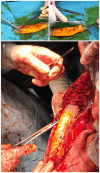Reconstruction of the Extensor Apparatus After Total Patellectomy in Orthopedic Oncology: A Systematic Literature Review
- PMID: 40725511
- PMCID: PMC12296086
- DOI: 10.3390/jcm14144818
Reconstruction of the Extensor Apparatus After Total Patellectomy in Orthopedic Oncology: A Systematic Literature Review
Abstract
Background: Patellar resection is recommended in cases of massive cortical bone disruption or malignancies. Modern literature lacks a consensus surgical reconstruction after total patellectomy. Our study reviews the surgical techniques described in the literature and summarizes the reported functional outcomes and complication rates. Materials: We systematically reviewed the existing literature, searching the PubMed, Embase, and Scopus databases for articles published between 1950 and 2024. We recorded age, diagnosis, tumor size, Lodwick classification, soft tissue involvement, and pre-operative fractures for each case or case series. We also recorded the reconstructive approaches. Complications, local recurrences, MSTS scores, and knee range of motion (ROM) were considered when reported. Results: Twenty-eight articles met our inclusion criteria. Among these, 4 were case series and 24 were case reports. A total of 47 cases treated with total patellectomy were reviewed. Reconstruction was performed with direct suture in 8 cases, while 17 had local augments, including allograft (10 cases), muscle flaps or transportations (4), autologous bone (1), or a composite (2). Reconstruction was not mentioned in 22 cases. ROM was reported for 17 cases, and the MSTS score was reported for 9 cases. Conclusions: In cases of relatively small tissue defects, a direct suture of the extensor apparatus can allow adequate functional recovery. In cases of larger gaps, surgeons should use muscle flaps, transfers, or soft tissue augments. Massive bone and tendon allografts should mainly be considered in cases where the neoplasm was not confined to the patella but extensively involved the patellar ligament or the quadriceps tendon.
Keywords: complications; functionality; local recurrence; patella; patellar ligament; quadriceps tendon; range of motion.
Conflict of interest statement
The authors declare no conflicts of interest.
Figures





Similar articles
-
What Are the Recurrence Rates, Complications, and Functional Outcomes After Multiportal Arthroscopic Synovectomy for Patients With Knee Diffuse-type Tenosynovial Giant-cell Tumors?Clin Orthop Relat Res. 2024 Jul 1;482(7):1218-1229. doi: 10.1097/CORR.0000000000002934. Epub 2023 Dec 28. Clin Orthop Relat Res. 2024. PMID: 38153106 Free PMC article.
-
Interventions for treating fractures of the patella in adults.Cochrane Database Syst Rev. 2015 Feb 27;(2):CD009651. doi: 10.1002/14651858.CD009651.pub2. Cochrane Database Syst Rev. 2015. Update in: Cochrane Database Syst Rev. 2021 Feb 24;2:CD009651. doi: 10.1002/14651858.CD009651.pub3. PMID: 25723760 Updated.
-
Extensor mechanism reconstruction with allograft following total knee arthroplasty: a systematic review and meta-analysis of achilles tendon versus extensor mechanism allografts for isolated chronic patellar tendon ruptures.Arch Orthop Trauma Surg. 2023 Jul;143(7):4411-4424. doi: 10.1007/s00402-022-04718-5. Epub 2022 Dec 3. Arch Orthop Trauma Surg. 2023. PMID: 36462060
-
Composite Reconstruction With Irradiated Autograft Plus Total Hip Replacement After Type II Pelvic Resections for Tumors Is Feasible but Fraught With Complications.Clin Orthop Relat Res. 2024 Oct 1;482(10):1825-1835. doi: 10.1097/CORR.0000000000003097. Epub 2024 Apr 26. Clin Orthop Relat Res. 2024. PMID: 38666740
-
[Volume and health outcomes: evidence from systematic reviews and from evaluation of Italian hospital data].Epidemiol Prev. 2013 Mar-Jun;37(2-3 Suppl 2):1-100. Epidemiol Prev. 2013. PMID: 23851286 Italian.
References
-
- Pluot E., Davies A., James S. Tumours and tumour-like lesions of the patella. In: Davies A., Sundaram M., James S., editors. Imaging of Bone Tumors and Tumor-Like Lesions. Medical Radiology. Springer; Berlin/Heidelberg, Germany: 2009. - DOI
Publication types
LinkOut - more resources
Full Text Sources
Miscellaneous

